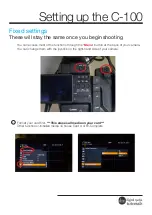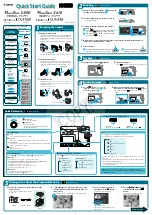
95
ķ
ķ
• Power Pack P76 with connecting cable V58-50 (optional accessory)
If your flash unit is not going to be used for an extended period of time,
remove the batteries.
Replacing batteries
The batteries are flat or dead if the recycling time (elapsing from the triggering of
a full-power flash, e.g. in the M mode, to the moment the flash ready indicator
lights up again) exceeds 60 seconds.
• Turn off the flash unit at the main switch
.
• Slide the battery compartment cover
downwards and fold open.
• Insert the batteries lengthwise as indicated by the battery symbols on the flash
unit, and close the battery compartment cover
.
When inserting batteries, ensure that the polarity is correct and matches
the symbols in the battery compartment. Inserting the batteries in the
wrong direction can destroy the flash unit!
Always replace all batteries simultaneously, and make sure that batteries
are the same brand and have the same capacity.
Flat or dead batteries should not be disposed of with ordinary household
waste. Help protect the environment, and dispose of flat/dead batteries
at the appropriate collection points.
3.3 Switching the flash unit on and off
The flash unit can be turned on by flipping the main switch
to the „ON“ position.
To turn off the flash unit, flip the main switch
to the left position.
If your flash unit is not going to be used for an extended period of time,
we recommend turning it off with the main switch and removing the
power source (i.e., batteries).
3.4 Power Pack P76 (optional accessory)
If a battery-operated flash does not meet your needs in terms of number of flas-
hes and recycling times, a Power Pack P76 (optional) can be connected to the
☞
☞
☞
flash unit to provide extra power. A V58-50 connecting cable (optional) is neces-
sary for connecting the Power Pack P76 to the flash unit.
In this case, no batteries have to be inserted into the flash unit.
When attaching the Power Pack P76 or the V58-50 connecting cable (accessory)
to the flash unit, the main switch of the flash must be in the left „OFF“ position.
The flash unit is then turned on or off using the switch on the Power Pack P76
(see Operating Instructions for the Power Pack).
To protect the flash unit from thermal overload when connected to the
Power Pack, a monitoring control increases the recycling times during
heavy usage. Both flash unit and Power Pack should be switched off
before the connecting cable is attached or removed from either unit.
3.5 Auto OFF for the flash unit
To save battery power and prevent inadvertent battery drain, the flash unit is fac-
tory-set to automatically switch to standby mode (Auto OFF) 10 minutes after
• being switched on,
• a flash is fired
• the shutter release is actuated
• the camera’s exposure metering system is switched off.
...The flash readiness indicator and the LC display are also switched off.
If the flash is manually switched on again, the last settings prior to the automatic
switch off are retained and immediately available. The flash unit can be reacti-
vated by pressing any button or by lightly depressing the shutter release (wake
up function).
The flash unit should always be turned off using the main switch
if it is
not going to be used for an extended period.
If necessary, the Auto OFF function can be set to occur after 1 minute of inactivi-
ty, or can be deactivated (see 7.11).
☞
☞
☞
706 47 0037-A3 58 AF-1 C 30.05.2007 8:52 Uhr Seite 95
















































